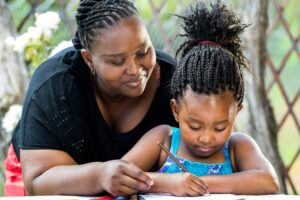Imagine you are on your way out the door and your 5-year-old is crying on the floor, your 8-year-old is yelling at them to stop crying, and you’re trying to talk over both of them to get them into the car. If this sounds familiar, keep reading! Almost every parent has experienced some rendition of this scene, power struggles and heightened stress levels included.
 Brain science like that explained in this paper from the Duke University Center for Child and Family Policy tells us that co-regulation between adults and children is an extremely supportive practice, and it can help reduce power struggles and tantrums. Here are a few ways to get started.
Brain science like that explained in this paper from the Duke University Center for Child and Family Policy tells us that co-regulation between adults and children is an extremely supportive practice, and it can help reduce power struggles and tantrums. Here are a few ways to get started.
First Things First – Breathe!
It’s really difficult to attend to an emotionally charged child when you are also emotionally escalated. Even if it’s brief, taking a few deep breaths can do wonders for our nervous system. Positive self-talk and talking to someone you feel safe with are also great ways to self-regulate.
Sound Discipline offers a free PDF download of 60 quick self-regulation activities including lots of breathing exercises you can do on the fly – in four languages!
Model Self-Regulation
Self-regulation is a foundational skill of early childhood. It’s the seed we plant that allows children to stay calm in stressful situations, and practicing self-regulation together is the water to help them grow into adults who can manage their emotions, thoughts, and behaviors. Thanks to mirror neurons, kids often mimic actions and behaviors they witness, which can be very effective if they witness their caregiver naming their emotions and self-regulating often.

Practice Co-Regulating Together
Co-regulating can look like doing a breathing exercise together, a walk in nature, or a brain break. It can also look like teaching emotional literacy, including recognizing emotions and using words to express more complex feelings. Even having a dance party can be regulating! Blowing bubbles is a kid-friendly way to practice deep breathing.
Name Your Feelings
To self-regulate, we need to notice, monitor, and recognize our feelings. Merely suppressing negative feelings and attempting to force ourselves out of dysregulation isn’t as effective as naming and processing our authentic feelings. Teaching children early on about emotional vocabulary is an excellent tool for emotional regulation. Modeling how to name emotions and adapt in difficult situations is also an effective strategy.
Practice, Practice, Practice
Self-regulation is a lifelong skill and takes lots of practice whether you’re an adult or a young person. According to Dr. Rouse, a clinical psychologist, “the key to learning self-regulation skills is not to avoid situations that are difficult for kids to handle, but to coach kids through them and provide a supportive framework. Clinicians call it “scaffolding” the behavior you want to encourage — until they can handle these challenges on their own.”
Make Use of a Calm Space
While you practice self-regulation and co-regulation with your child, try to make your environment as calm as possible (to the extent that you can control). Less technology and distractions will allow more opportunity for you and your child to authentically connect and co-regulate together in a calm space.
You can even create an intentional cool-down space or calm corner in your home and help your child practice their self-regulation skills and recognize when they can use it if they become dysregulated.
Remember, this is a lifelong practice, so have patience with yourself and your child as you build new self and co-regulation skills together!
